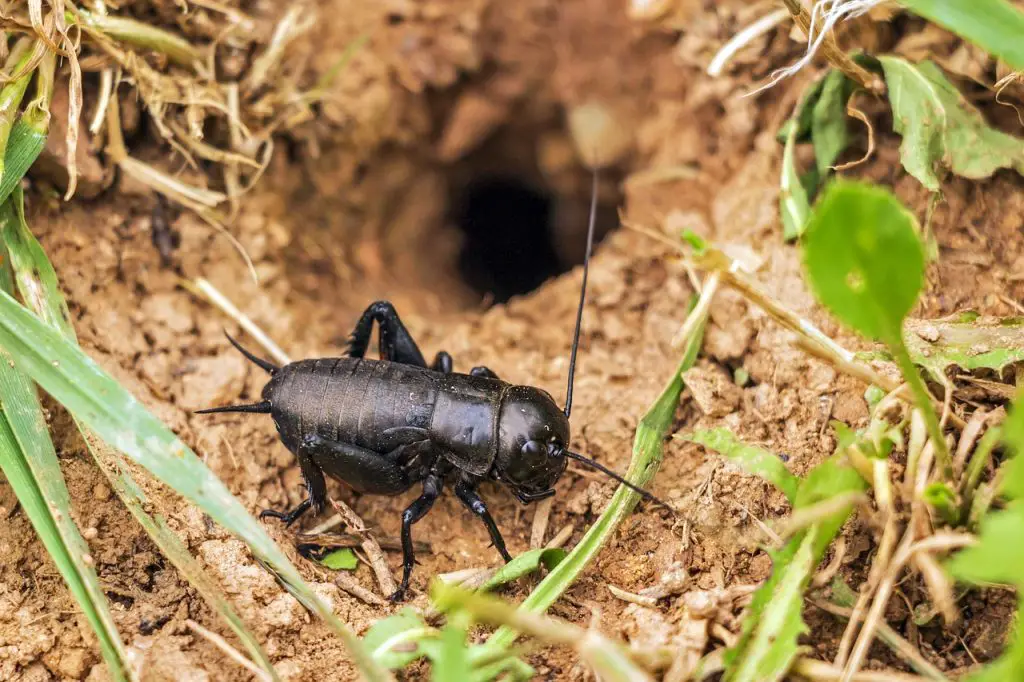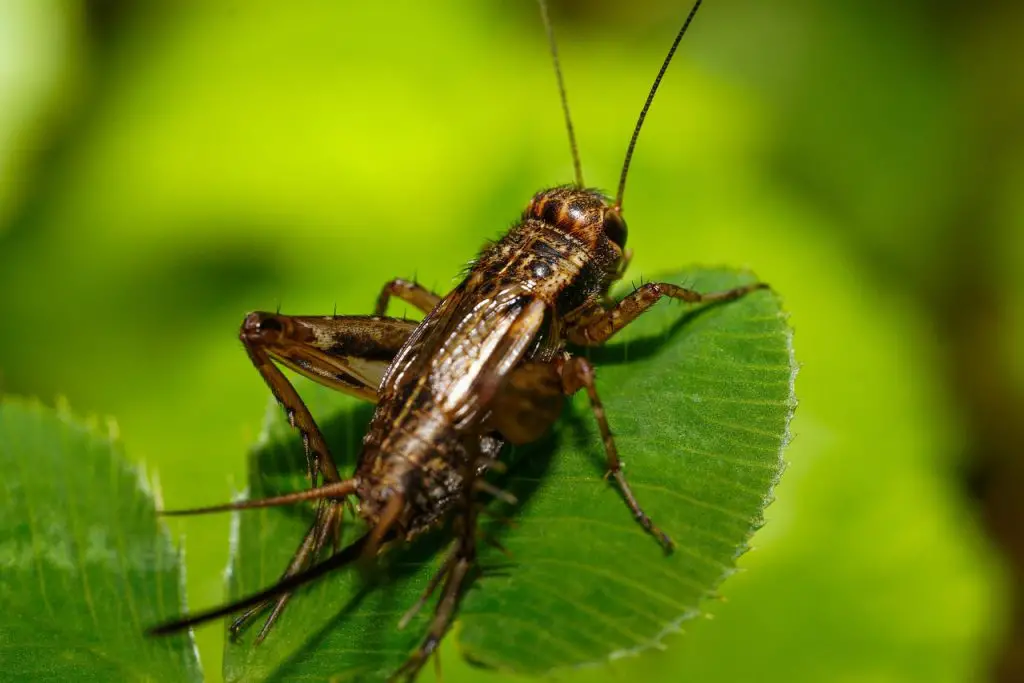Crickets tend to be on the menu for lots of different critters. But what do crickets eat themselves? You are in the right place to find out! We will explore everything that crickets eat.
Key facts:
- Different species of crickets have different dietary preferences.
- Some crickets will eat leaves, grain, fruit, insects, meat, and more.
What Do Crickets Eat?

Crickets, being omnivorous creatures, have a varied and adaptable diet that allows them to thrive in diverse environments. They primarily feed on organic matter such as decaying plant material, fallen fruits, leaves, and grasses. These plant-based foods form a substantial part of their diet, supplying essential nutrients and energy to sustain themselves.
Additionally, crickets are opportunistic feeders, meaning they won’t hesitate to devour small insects, such as aphids, caterpillars, and even their fellow cricket nymphs. This carnivorous aspect of their diet provides them with a crucial protein source, vital for their growth, development, and reproduction.
In captivity, if you plan to keep crickets as feeder insects for reptiles or other pets, it’s important to provide them with a balanced diet. Commercial cricket diets are available that contain a combination of grains, legumes, and essential vitamins and minerals. Adding fresh fruits and vegetables like carrots, apples, or lettuce can further enhance their nutritional value.
What Do Crickets Eat? A List
Here’s a quick list of some of the many things that crickets like to eat:
- Decaying plant material
- Fallen fruits
- Leaves
- Grasses
- Aphids
- Caterpillars
- Other small insects
- Commercial cricket diets (in captivity)
- Fresh fruits and vegetables (in captivity) like carrots, apples, lettuce, etc.
What Do Crickets Eat In Captivity?
In captivity, providing a nutritious and well-balanced diet for crickets is essential to ensure their health and longevity. While their wild diet consists of various natural resources, replicating this in captivity can be challenging. Therefore, a combination of commercial cricket diets and fresh fruits and vegetables is often employed to meet their nutritional needs.
Commercial cricket diets are specifically formulated to provide crickets with a balanced mix of essential nutrients, vitamins, and minerals. These diets usually consist of a combination of grains, legumes, and other plant-based ingredients. They offer a convenient and reliable option for pet owners, breeders, or enthusiasts who keep crickets as feeder insects for reptiles, birds, or other insectivorous animals.
To enhance the nutritional value and add variety to their diet, fresh fruits and vegetables can also be offered to captive crickets. Carrots, apples, lettuce, and potatoes are some examples of suitable fruits and vegetables that can be provided to these insects. These items not only supply additional nutrients but also serve as a source of hydration for the crickets.
It is crucial to ensure that the food provided in captivity is fresh and free from any contaminants. Regularly cleaning the cricket enclosures and removing uneaten food can help maintain a healthy environment and prevent the risk of disease.
How Do Crickets Forage?

Crickets are highly skilled foragers, utilizing their keen senses and physical adaptations to find food in their surrounding environment. Their foraging behavior is essential for their survival and plays a crucial role in maintaining the balance of their ecosystem. When searching for food, crickets rely on a combination of sight, touch, and smell to detect potential food sources.
During the daytime, crickets are more likely to be found in hidden or sheltered areas, as they are nocturnal insects and prefer to forage during the night. As the sun sets and darkness falls, crickets become more active and begin their search for food. They use their long antennae to sense the environment, picking up scents and vibrations to locate potential food items.
Crickets have mandibles that function as chewing mouthparts, allowing them to break down plant material and small insects with ease. Their diet is diverse, ranging from decaying plant matter and fallen fruits to smaller insects, all of which are sought out and consumed during their nocturnal expeditions.
In their search for sustenance, crickets demonstrate impressive adaptability, adjusting their foraging behavior based on seasonal changes and food availability. In times of abundance, they may become less selective in their choices, while during periods of scarcity, they become more efficient at locating and consuming the most nutritious food sources.
What Do Baby Crickets Like to Eat?
Baby crickets, also known as nymphs, have specific dietary requirements to support their rapid growth and development.
The primary food source for baby crickets is typically finely ground plant material. This can include finely powdered commercial cricket diets that are specifically designed to meet the nutritional needs of nymphs. These diets often contain a blend of essential nutrients, proteins, and vitamins crucial for their growth.
Apart from commercial diets, baby crickets can also consume finely chopped fresh fruits and vegetables. Items like finely grated carrots, apples, and leafy greens are ideal for their tiny mouths and delicate digestive systems. Providing a variety of fruits and vegetables can ensure a more diverse and balanced diet for the young crickets.
Water is equally important for baby crickets, as they require sufficient hydration for their growth and molting processes. Spraying a small amount of water or providing a water source like a damp sponge can help keep them hydrated.
What Do Crickets Eat: Frequently Asked Questions
You have questions about what do crickets eat? I have answers.
How long do crickets live?
Crickets typically have a relatively short lifespan, living anywhere from a few weeks to a few months, depending on the species and environmental conditions. In the wild, their life expectancy can be influenced by factors such as predation, food availability, and climate. In captivity, proper care and optimal conditions may extend their lifespan slightly beyond their wild counterparts.
Do crickets eat live bugs?
Yes, crickets are known to be omnivorous and will eat live bugs. They are opportunistic feeders and, in addition to their plant-based diet, they will consume small insects like aphids, caterpillars, and other small arthropods when given the opportunity. This carnivorous aspect of their diet provides them with essential protein for their growth and development.
What attracts crickets to a home?
Crickets are attracted to homes and indoor spaces primarily by the presence of food sources and shelter. They are drawn to decaying organic matter, fallen fruits, and crumbs left behind, making kitchens and dining areas potential hotspots. Additionally, the warm and dark environment of homes provides suitable shelter for crickets, making them seek refuge indoors, especially during cooler weather or at night. Proper sanitation, sealing cracks and gaps, and reducing outdoor lighting can help deter crickets from invading homes.
Final Take
Crickets aren’t very picky eaters. The small creatures seem willing to eat most things that come their way, and fits into their mouths. If you are keeping crickets in capitivty, consider using a commercial feed specifically designed to meet the nutritional needs of these critters.